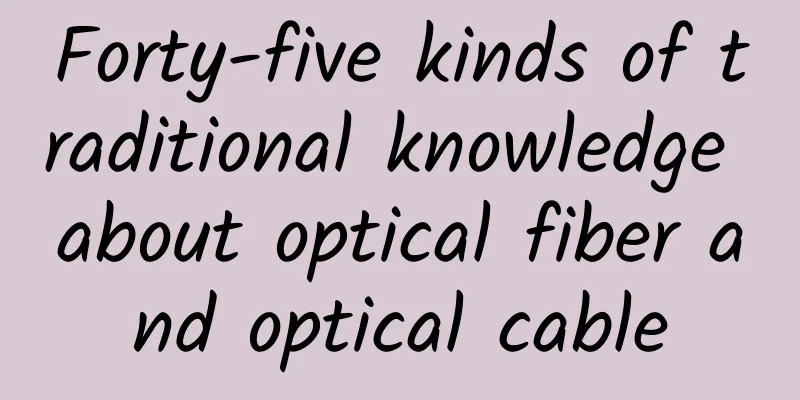Forty-five kinds of traditional knowledge about optical fiber and optical cable

|
1. Briefly describe the composition of optical fiber. Answer: Optical fiber consists of two basic parts: the core and cladding, which are made of transparent optical material. 2. What are the basic parameters that describe the transmission characteristics of optical fiber lines? Answer: Including loss, dispersion, bandwidth, cut-off wavelength, mode field diameter, etc. 3. What causes fiber attenuation? A: Fiber attenuation refers to the reduction of optical power between two cross sections of a fiber, which is related to wavelength. The main causes of attenuation are scattering, absorption, and optical loss caused by connectors and joints. 4. How is the optical fiber attenuation coefficient defined? Answer: It is defined by the attenuation per unit length of a uniform optical fiber in steady state (dB/km).
5. What is insertion loss? Answer: It refers to the attenuation caused by inserting optical components (such as inserting connectors or couplers) into the optical transmission line. 6. What does the bandwidth of optical fiber depend on? A: The bandwidth of an optical fiber refers to the modulation frequency at which the amplitude of the optical power decreases by 50% or 3dB compared to the amplitude of the zero frequency in the transfer function of the optical fiber. The bandwidth of an optical fiber is approximately inversely proportional to its length, and the product of the bandwidth and length is a constant. 7. How many types of optical fiber dispersion are there? What are they related to? Answer: Fiber dispersion refers to the broadening of the group delay within a fiber, including modal dispersion, material dispersion and structural dispersion. It depends on the characteristics of both the light source and the fiber. 8. How to describe the dispersion characteristics of signals propagating in optical fibers? Answer: It can be described by three physical quantities: pulse broadening, fiber bandwidth, and fiber dispersion coefficient. 9. What is the cut-off wavelength? A: It refers to the shortest wavelength that can only transmit the fundamental mode in the optical fiber. For single-mode optical fiber, its cut-off wavelength must be shorter than the wavelength of the transmitted light. 10. What effect does the dispersion of optical fiber have on the performance of optical fiber communication systems? Answer: The dispersion of optical fiber will cause the optical pulse to be broadened during transmission in the optical fiber, affecting the bit error rate, the transmission distance, and the system rate. 11. What is backscattering? A: The backscattering method is a method for measuring attenuation along the length of an optical fiber. Most of the optical power in the optical fiber propagates forward, but a small part is backscattered toward the light emitter. Using a spectrometer at the light emitter to observe the time curve of backscattering, not only can the length and attenuation of the connected uniform optical fiber be measured from one end, but also local irregularities, breakpoints, and optical power loss caused by joints and connectors can be measured. 12. What is the testing principle of Optical Time Domain Reflectometer (OTDR)? What are its functions? A: OTDR is based on the principle of light backscattering and Fresnel reflection. It uses the backscattered light generated when light propagates in the optical fiber to obtain attenuation information. It can be used to measure optical fiber attenuation, joint loss, optical fiber fault point location, and understand the loss distribution along the length of the optical fiber. It is an indispensable tool in optical cable construction, maintenance and monitoring. Its main indicators include: dynamic range, sensitivity, resolution, measurement time and blind area. 13. What is the blind area of OTDR? What is the impact on the test? How to deal with the blind area in actual testing? Answer: The series of "blind spots" caused by saturation of the OTDR receiving end due to reflections generated by characteristic points such as active connectors and mechanical joints are usually called blind areas. The blind areas in optical fibers are divided into event blind areas and attenuation blind areas. The length from the starting point of the reflection peak to the receiver saturation peak caused by the intervention of active connectors is called the event blind area. The length from the starting point of the reflection peak to other identifiable event points caused by the intervention of active connectors in optical fibers is called the attenuation blind area. For OTDR, the smaller the blind area, the better. The blind area will increase with the increase of pulse width. Although increasing the pulse width increases the measurement length, it also increases the measurement blind area. Therefore, when testing optical fiber, narrow pulses should be used to measure the optical fiber attached to the OTDR and the adjacent event points, while wide pulses should be used to measure the far end of the optical fiber. 14. Can OTDR measure different types of optical fibers? A: If you use a single-mode OTDR module to measure a multimode fiber, or use a multimode OTDR module to measure a single-mode fiber with a core diameter of 62.5 mm, the measurement result of the fiber length will not be affected, but the results of fiber loss, optical connector loss, and return loss will be incorrect. Therefore, when measuring optical fiber, you must select an OTDR that matches the fiber being measured to obtain correct results for all performance indicators. 15. What does "1310nm" or "1550nm" mean in common optical test instruments? A: It refers to the wavelength of the optical signal. The wavelength range used in optical fiber communication is in the near-infrared region, between 800nm and 1700nm. It is often divided into short wavelength band and long wavelength band, the former refers to 850nm wavelength, and the latter refers to 1310nm and 1550nm. 16. In current commercial optical fibers, which wavelength of light has the least dispersion? Which wavelength of light has the least loss? Answer: Light with a wavelength of 1310nm has the smallest dispersion, and light with a wavelength of 1550nm has the smallest loss. 17. How are optical fibers classified based on the change in the refractive index of the optical fiber core? A: It can be divided into step-index fiber and gradient-index fiber. Step-index fiber has a narrower bandwidth and is suitable for small-capacity short-distance communications; gradient-index fiber has a wider bandwidth and is suitable for medium- and large-capacity communications. 18. How are optical fibers classified according to the different modes of light waves transmitted in them? A: It can be divided into single-mode fiber and multi-mode fiber. The core diameter of single-mode fiber is about 1 to 10 μm. At a given working wavelength, it only transmits a single fundamental mode, which is suitable for large-capacity and long-distance communication systems. Multi-mode fiber can transmit multiple modes of light waves, with a core diameter of about 50 to 60 μm, and its transmission performance is worse than that of single-mode fiber. When transmitting the current differential protection of multiplexed protection, multimode optical fiber is often used between the optoelectronic conversion device installed in the communication room of the substation and the protection device installed in the main control room. 19. What is the significance of the numerical aperture (NA) of step-index optical fiber? Answer: Numerical aperture (NA) indicates the light-collecting ability of optical fiber. The larger the NA, the stronger the light-collecting ability of optical fiber. 20. What is birefringence in single-mode optical fiber? Answer: There are two orthogonal polarization modes in single-mode optical fiber. When the optical fiber is not completely cylindrically symmetrical, the two orthogonal polarization modes are not degenerate. The absolute value of the difference between the refractive indices of the two orthogonal polarization modes is birefringence. 21. What are the most common optical cable structures? Answer: There are two types: layer twisted type and skeleton type. 22. What are optical cables mainly composed of? Answer: It is mainly composed of: fiber core, optical fiber grease, sheath material, PBT (polybutylene terephthalate) and other materials. 23. What does the armor of optical cable refer to? A: It refers to the protective element (usually steel wire or steel belt) used in special-purpose optical cables (such as submarine optical cables, etc.). The armor is attached to the inner sheath of the optical cable. 24. What material is used for the optical cable sheath? Answer: The optical cable sheath or protective layer is usually made of polyethylene (PE) and polyvinyl chloride (PVC) materials. Its function is to protect the cable core from external influences. 25. List the special optical cables used in power systems. A: There are three main types of special optical cables:
26. How many application structures are there for OPGW optical cables? Answer: There are mainly: 1) Plastic tube layer twisted + aluminum tube structure; 2) Central plastic tube + aluminum tube structure; 3) Aluminum skeleton structure; 4) Spiral aluminum tube structure; 5) Single-layer stainless steel tube structure (central stainless steel tube structure, stainless steel tube layer twisted structure); 6) Composite stainless steel tube structure (central stainless steel tube structure, stainless steel tube layer twisted structure). 27. What are the stranded wires outside the OPGW optical cable core mainly composed of? Answer: It is composed of AA wire (aluminum alloy wire) and AS wire (aluminum clad steel wire). 28. What are the technical requirements for selecting OPGW optical cable models? Answer: 1) Nominal tensile strength (RTS) of OPGW optical cable (kN); 2) Number of optical fiber cores of OPGW optical cable (SM); 3) Short-circuit current (kA); 4) Short-circuit time (s); 5) Temperature range (℃). 29. How is the bending degree of optical cables limited? Answer: The bending radius of the optical cable should not be less than 20 times the outer diameter of the optical cable, and during the construction process (non-static state), it should not be less than 30 times the outer diameter of the optical cable. 30. What should be paid attention to in ADSS optical cable projects? Answer: There are three key technologies: optical cable mechanical design, determination of suspension points and selection and installation of supporting hardware. 31. What are the main types of optical cable fittings? Answer: Optical cable fittings refer to the hardware used to install optical cables, mainly including: tension clamps, suspension clamps, vibration isolators, etc. 32. What are the two most basic performance parameters of optical fiber connectors? Answer: Fiber optic connectors are commonly known as live joints. The requirements for the optical performance of single-fiber connectors focus on the two most basic performance parameters: insertion loss and return loss. 33. How many types of commonly used fiber optic connectors are there? Answer: According to different classification methods, optical fiber connectors can be divided into different types. According to different transmission media, they can be divided into single-mode optical fiber connectors and multi-mode optical fiber connectors; according to different structures, they can be divided into various types such as FC, SC, ST, D4, DIN, Biconic, MU, LC, MT, etc.; according to the pin end face of the connector, they can be divided into FC, PC (UPC) and APC. Commonly used optical fiber connectors: FC/PC optical fiber connector, SC optical fiber connector, LC optical fiber connector. 34. In fiber optic communication systems, the following items are commonly found. Please indicate their names. AFC, FC adapterST adapterSC adapterFC/APC, FC/PC connectorSC connectorST connectorLC patch cordMU patch cordSingle-mode or multi-mode patch cord 35. What is the insertion loss (or insertion loss) of a fiber optic connector? A: What is the return loss (or reflection attenuation, return loss, return loss) of a fiber optic connector? 36. What is the return loss (or reflection attenuation, return loss, return loss) of a fiber optic connector? A: It is a measure of the input power component that is reflected from the connector and returned along the input channel. Its typical value should be no less than 25dB. 37. What is the most prominent difference between the light emitted by light emitting diodes and semiconductor lasers? Answer: The light produced by the light-emitting diode is incoherent light with a wide spectrum; the light produced by the laser is coherent light with a very narrow spectrum. 38. What is the most obvious difference between the operating characteristics of light emitting diodes (LEDs) and semiconductor lasers (LDs)? Answer: LED has no threshold, but LD has a threshold. Laser will only be generated when the injected current exceeds the threshold. 39. What are the two commonly used single longitudinal mode semiconductor lasers? Answer: Both DFB laser and DBR laser are distributed feedback lasers, and their optical feedback is provided by the distributed feedback Bragg grating in the optical cavity. 40. What are the two main types of optical receiving devices? Answer: There are mainly photodiodes (PIN tubes) and avalanche photodiodes (APDs). 41. What are the factors that cause noise in optical fiber communication systems? Answer: There are noises caused by unqualified extinction ratio, noises caused by random changes in light intensity, noises caused by time jitter, point noises and thermal noises of the receiver, mode noises of the optical fiber, noises caused by pulse broadening due to dispersion, mode distribution noises of LD, noises caused by frequency chirp of LD and noises caused by reflection. 42. What are the main optical fibers currently used in transmission network construction? What are their main features? Answer: There are mainly three types, namely G.652 conventional single-mode fiber, G.653 dispersion-shifted single-mode fiber and G.655 non-zero dispersion-shifted fiber.
Answer: It means that when the optical power input to the fiber exceeds a certain value, the refractive index of the optical fiber will be nonlinearly related to the optical power, and Raman scattering and Brillouin scattering will occur, causing the frequency of the incident light to change. 44. What impact does optical fiber nonlinearity have on transmission? A: Nonlinear effects will cause some additional losses and interference, deteriorating the performance of the system. The optical power of the WDM system is large and is transmitted over a long distance along the optical fiber, so nonlinear distortion occurs. There are two types of nonlinear distortion: stimulated scattering and nonlinear refraction. Stimulated scattering includes Raman scattering and Brillouin scattering. The above two types of scattering reduce the energy of the incident light, causing loss. They can be ignored when the input fiber power is small. 45. What is PON (Passive Optical Network)? Answer: PON is a fiber-optic loop optical network in the local user access network, based on passive optical devices such as couplers and splitters. |
<<: What opportunities and challenges will the Internet of Things face when it meets blockchain?
Recommend
Huawei releases the "Digital Energy Zero Carbon Network Solution" to fully help operators achieve carbon neutrality goals
At the Huawei media communication meeting held du...
Cool down the false millimeter wave! Adhere to the road of confidence and look at the millimeter wave rationally
Last year, a manufacturer raised a very interesti...
Sharktech Spring Promotion, 10Gbps unlimited traffic high-defense server starting from $299/month, 2*E5-2678v3/128G/2TB NVMe/4 computer rooms including Los Angeles
Sharktech has launched a spring promotion, with d...
Real-time communication technology battle
[[395758]] This article is reprinted from the WeC...
RAKsmart cloud servers start at 10% off, Hong Kong/Japan/Los Angeles/San Jose cloud servers start at 129 yuan/year
RAKsmart data center has launched the "Every...
RIP is the originator of dynamic routing. Although it is not used much now, you can learn more about it when you have time.
1. Introduction to RIP RIP (Routing Information P...
Ericsson: Global 5G users will exceed 580 million by the end of the year
According to foreign media, Ericsson recently rel...
TCP Things 1: TCP Protocol, Algorithm and Principle
TCP is a very complex protocol because it has to ...
The 2020 Huawei Ecosystem Partner Elite Competition opens up a channel for ICT talent training and provides the industry with "experts"
[51CTO.com original article] The severe situation...
Empowering online learning, H3C University won the "Bio-Best Ecological Platform Application Award"
On November 19, 2020, the 12th CEFE China Enterpr...
How should a small LAN with less than 10 or 100 people be established?
What is a local area network? The so-called local...
Ruijie Networks: Linking Network + Security to Prevent Campuses from Becoming "Mines"
Campus networks have a large number of users and ...
Huawei releases next-generation smart product strategy and new +AI series products
[Shanghai, China, September 18, 2019] During HUAW...
Don’t be bothered by the information of network equipment optical modules anymore! Come and learn these practical tips!
The optical module power is abnormal! What should...
Ruijie Networks Tailors the Campus Network for Guizhou University of Finance and Economics
Guizhou University of Finance and Economics (here...









